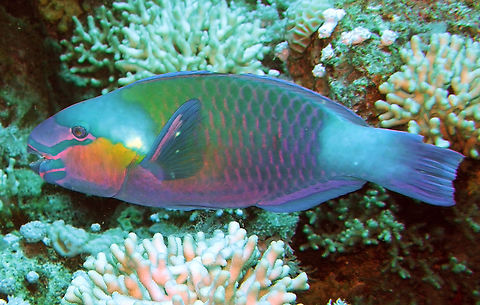
Appearance
The initial phase has very variable colouration. The smaller fishes can be a uniform dark brown to light gray and they may or may not possess a light band surrounding a dark spot on the caudal peduncle. Larger specimens can show a series of irregular rows of small, light spots towards the tail or they may have the light band surrounding the dark spot on the caudal peduncle. The terminal phase, male, is also variable and may have a large tan area on the flanks or on its caudal peduncle. It has a rounded snout."Chlorurus sordidus" is a medium size fish and can reach a maximum size of 40 cm length.
Distribution
"Chlorurus sordidus" is widespread throughout the tropical waters of the Indo-Pacific region, Red Sea included.Behavior
Before going to sleep, "Chlorurus sordidus" secretes a mucus which surrounds the fish in a complete cocoon. The purpose of this mucus cocoon is not completely understood, but one theory is that it protects the fish from parasitic gnathidds. This species is known to be predated on by the honeycomb grouper and the coral trout, its parasites include the monogenean "Benedenia scari". It is a sociable fish which schools with other parrotfishes such as "Scarus psittacus"."Chlorurus sordidus" is one of the most widespread species of parrotfish, and it is highly variable with some of the geographically determined forms probably being at least subspecies. It occurs in both coral rich and open pavement areas of shallow reef flats, in lagoon reefs and seaward reefs, it can also be found at drop-offs. The juveniles inhabit areas of coral rubble in reef flats and lagoons. The juveniles and females in their initial phase form large groups that move long distances between their feeding grounds and the areas used for sleeping at night. They feed on benthic algae. This species is a protogynous hermaphrodite and the sex change occurs when the attain a total length of 35.1–47.2 centimetres.
Habitat
Before going to sleep, "Chlorurus sordidus" secretes a mucus which surrounds the fish in a complete cocoon. The purpose of this mucus cocoon is not completely understood, but one theory is that it protects the fish from parasitic gnathidds. This species is known to be predated on by the honeycomb grouper and the coral trout, its parasites include the monogenean "Benedenia scari". It is a sociable fish which schools with other parrotfishes such as "Scarus psittacus"."Chlorurus sordidus" is one of the most widespread species of parrotfish, and it is highly variable with some of the geographically determined forms probably being at least subspecies. It occurs in both coral rich and open pavement areas of shallow reef flats, in lagoon reefs and seaward reefs, it can also be found at drop-offs. The juveniles inhabit areas of coral rubble in reef flats and lagoons. The juveniles and females in their initial phase form large groups that move long distances between their feeding grounds and the areas used for sleeping at night. They feed on benthic algae. This species is a protogynous hermaphrodite and the sex change occurs when the attain a total length of 35.1–47.2 centimetres.
References:
Some text fragments are auto parsed from Wikipedia.